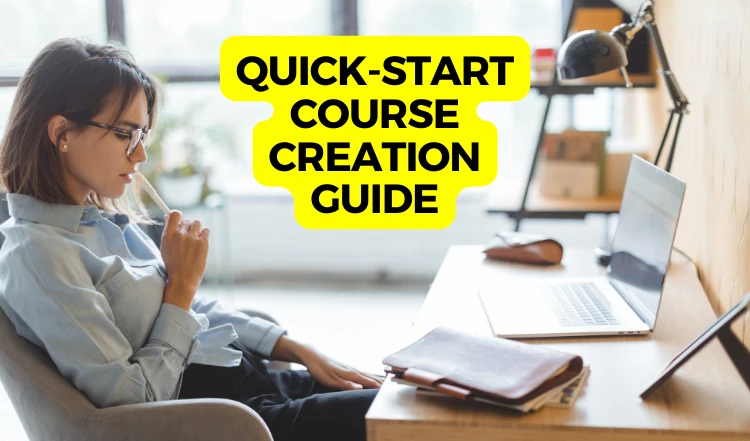This article is designed as a guide to quickly take you from finding an idea for your new (or next) online course, to the platform you choose, and how to price it. First, we’ll start off with where all courses and content must begin… the idea. What should you teach?
9 Ways to Find Killer Ideas for Your Next Online Course
Here’s the number one question I hear—not only from new product creators, but even from seasoned business owners: “How do I find a good idea?”
What they really mean, of course, is “How do I find an idea that will sell?” No one wants to spend days or weeks or more planning, developing and launching a course only to hear crickets on the big day. You want to know you’ll have at least some measure of success.
But don’t overthink it. The answer is simple. Just give your audience what they are asking for.
- Check out the competition. What are they creating? If you serve a similar audience, then what sells for them will very likely sell for you. Now, before you break out the “But it’s already been done!” line, keep this in mind: No two coaches are alike. You may create a similar course, but your voice, your experience, your teaching style, and your personality are all very different. No one else is you, and for some customers, YOU are the only one who will resonate with them.
- Pay attention to your ideal client. What questions does she ask in private groups, in your help desk, and elsewhere? What posts are attracting the most attention on your blog (check your Google Analytic stats)? These are all valuable sources of intel about exactly what she needs and wants from you.
- Ask. Still not sure what your dream client is looking for? Ask her. Create a survey and ask her to tell you what she struggles with, what keeps her from realizing her success, and even what she’s tried before in an effort to solve her issues.
- Check the bestsellers list. Which books in your niche are outperforming others? These are the ones that offer answers your clients are seeking. Flip through the table of contents and read the online reviews to dig deep into the topics that really resonate with your audience.
- Read the FAQs. Check the frequently asked questions section on competitor blogs and in forums and Facebook groups. Also check blogs for “Start Here,” and “Quickstart” pages. Many times the most common questions and concerns are addressed here.
- Review the available resources. Which are the most common resources your colleagues and competitors are recommending? There are often questions surrounding the use of software and other tools, and these can be great ideas for courses.
- Check your email. If you’ve been in business for more than a few months, chances are you receive questions from friends, clients and even strangers on a daily basis. What are they asking about? Look for common themes and trends.
- Revisit your keyword research. Review the terms and phrases that your community most frequently searches on, and use them as a basis for your own research.
- Check your search terms. Google Webmaster Tools allows you to check which terms are sending visitors to your website. Since people often search on questions (“how to design a logo” or “how to start a business”) this can be a rich source of ideas.
Ideas are everywhere. Your potential buyers are sharing them with you each and every day, if you just know where to look. So don’t let your insecurities hold you back. Develop the course they are asking you for, but, keep it simple! Simplicity leads to success because it’s easier for people to relate to simple.

Single Problem, Single Solution: The Benefits of Keeping It Simple
Tell me if this sounds familiar. You begin to write a blog post, and before you know it, your “quick update” has turned into a rambling, 3,000 word novelette that covers everything from where to find a graphic designer to how to design a business card.
Now, a 3,000-word blog post can be great for traffic, but only if you’ve kept it tightly focused. But what happens all too often (in blog posts and in course development) is that every point covered brings up a new point to be addressed.
Logo design leads to business card formatting.
Business cards lead to taglines.
Taglines lead to ideal client avatars.
Avatars lead to…well, you get the idea. The point is, when you strive to provide the very best information for your audience, it’s easy to want to include one more important detail. Soon, you’ve outlined an encyclopedia’s worth of content that overwhelms not only you, but your clients as well.
One Problem, One Solution
Most people don’t need or want an all-inclusive answer. If your course helps your clients identify their ideal client, then including information about choosing a domain name might seem relevant, when it’s really just a distraction.
Worse, if you try to branch out too much, you run the risk of overwhelming your customer. Too much of that, and she’ll log out and never return—for this or any other course you create. Not because you’re a bad coach, but because she’ll be convinced she’s a bad student.
Here’s another issue with trying to include too much info in a single course: Depth of knowledge. When you try to include too much information, what you end up with is very thin coverage of a lot of different topics.
Instead, when you focus your course on a single problem and a single solution, you can dig deeper and present ideas and information that won’t be found just anywhere, such as:
- Case studies
- Worksheets
- Planning documents
- Checklists
- Multimedia content
These are the types of things that your audience will happily pay a premium for, because they cannot find them elsewhere. When you focus your course on a single problem, you’ll have the leeway to create these and other resources. Take a broader approach, though, and you’ll be forced to scrimp on the “extras.”
But make no mistake—there is still room for that all-inclusive, massive eCourse. One look at powerhouse coaches such as Marie Forleo and her massively popular B-School will tell you that.
Keep in mind, though, that if you decide to go ahead with an online course of this magnitude, you will (by necessity) have to:
- Expand the length of the course to accommodate all the extra information. Each week (or module) becomes its own “mini” course, focused on a single issue/solution.
- Increase the cost of the course. If your market will bear a high-ticket, multi-module course, then by all means you should produce one. But do keep in mind that the more information you provide, the higher the price point.
Remember, too, that a large course is a much more difficult sell—and we’re not just talking about the price. There’s a bigger commitment on the part of the buyer as well, and that’s something she’s going to have to carefully consider before she takes the plunge. A smaller, single-problem course is easier to commit to and easier to complete and be successful with.

How to Choose the Right Course Format for Your New Online Course
Video? Audio? Written? Hybrid? Live?
When it comes to creating course content, you have a dozen or more options, and all of them are useful in their own way, so how can you choose? There are three primary considerations.
Your Buyer
Chances are, your ideal client has a clear preference in format. Some people love watching videos, while some prefer to skim through written instructions. Some people learn best by doing, with a checklist as a guide. Still others much prefer to have audio they can consume while doing other things.
Your Content
Let’s face it, some information lends itself well to certain formats, and simply won’t work in others. It’s difficult to explain how to use software, for example, without a screenshare video. By the same token, if you’re asking clients to work through a discovery process, a fillable worksheet is a must.
Your Comfort Zone
While your biggest consideration should be your clients and their needs, your preferences matter, too. If you aren’t comfortable with video, then it’s a safe bet you’ll procrastinate getting your course done, and stress over it unnecessarily. By the same token, if writing isn’t your forte, trying to force yourself to create 50 pages of content is going to be frustrating.
Beyond the obvious format choice, you also have to consider how you’ll present the material. Again, you have a variety of options.
Email Delivery
This is the simplest method of course delivery. All it takes is an autoresponder set to go out on the schedule you choose, and a series of messages with your training materials. You can include attachments as well (although your delivery rates may suffer) or you can link to a page where buyers will find more resources, such as video or downloadable files.
Membership Site
A more sophisticated option is to set up a membership portal where buyers can log in to retrieve their material. This gives you the option to deliver the content all at one time if you prefer, and also allows you to better protect your content from unauthorized access.
Of course, you may prefer to use a service such as Udemy or Coursera to deliver your online course.
Zip File Download
If your course is small, or if you aren’t concerned about overwhelming your buyers, a zip file download is a viable option. In this case, you simply set up delivery through your shopping cart by providing a link where buyers can download the entire course. This format works best if your course does not include a video element, because the download could be too large for those with a slow internet connection.
The bottom line is this: When you’re planning your eCourse, your most important consideration is your buyer. What does she want, and how does she want it delivered? Do that, and you’ll be well on your way to launching a successful course.
What To Charge? Pricing Strategies That Work
Struggling with how to price your course? You’re in good company. It’s a struggle all online business owners face, and one that can even cause you to put off launching your product—maybe indefinitely.
Sound familiar? These pricing strategies will help:
How much do you want to earn?
Here’s the most basic idea: how much money do you want to make on your course sales? Take into consideration:
- Your time investment: How many hours did you spend planning and creating your course?
- Your monetary investment: Did you pay writers, editors, developers or others to create your course?
- The cost of sales: What percentage of each sale will go to pay your payment processor, affiliates and JV partners?
- Projected sales: How many individual units can you reasonably expect to sell?
With all that in mind, it’s easier to calculate the cost of your course.
What is the return on investment?
Beyond how much you expect to earn from course sales, it’s important to consider how much your buyer stands to earn from her access to it. For example, if your students routinely increase their income by $2,000 every month thanks to your training, then it’s more than reasonable to charge $4,000 or more for your course. After all, action takers will earn back many times their investment.
How committed are your buyers?
Or more accurately, how committed do you want them to be? Generally speaking, the higher the price point, the more invested a buyer will be in:
- Seeing the course through to the end
- Taking action on the material
This means that they’re also more likely to realize the results you promise, which leads to a better return on their investment. If you have the value and the case studies to prove a solid return, it’s reasonable to price your course higher to encourage commitment on your buyers’ part.
With all that in mind, it’s easier to calculate the cost of your course.
What is the return on investment?
Beyond how much you expect to earn from course sales, it’s important to consider how much your buyer stands to earn from her access to it. For example, if your students routinely increase their income by $2,000 every month thanks to your training, then it’s more than reasonable to charge $4,000 or more for your course. After all, action takers will earn back many times their investment.
How committed are your buyers?
Or more accurately, how committed do you want them to be? Generally speaking, the higher the price point, the more invested a buyer will be in:
- Seeing the course through to the end
- Taking action on the material
This means that they’re also more likely to realize the results you promise, which leads to a better return on their investment. If you have the value and the case studies to prove a solid return, it’s reasonable to price your course higher to encourage commitment on your buyers’ part.
How exclusive is the content?
You might think that there is nothing you can teach that hasn’t already been done before—many, many times.
But there’s plenty that can make your course stand out from the crowd:
- Present the content in an unexpected way
- Use design elements such as cover art, charts, and other graphics
- Include worksheets, checklists, and other step-by-step help
In the end, though, deciding on a price for your course might come down to simply following your intuition. After all, you know your audience—and your content—best. Don’t overthink it, and don’t use pricing as an excuse not to launch.

How to Create Your New Course in a Day
Think you don’t have time to create a course? Think again. Many of the courses you’ve seen for sale—or maybe even purchased—were created in a single day. For savvy business owners, creating a new course is just a matter of putting the pieces together. If you’ve been in business for more than a few weeks, you already have everything you need to create an ecourse and have it ready for sale by this time tomorrow.
Use Your Strengths
You could spend days or weeks researching new strategies, testing new ideas, and developing a completely new (to you) course. Or you can embrace a tried and true development strategy that’s been proven to work: Write what you know.
When you’ve spent months or years immersed in your expertise, it’s easy to talk about. You probably do it every day. You answer emails, write blog posts, chat on the phone with clients. Not only that, but you very likely read, watch videos, and listen to podcasts about your subject matter every single day. All of these things make it easy for you to create a new course, seemingly out of thin air.
Repurpose Your Content
If you have a blog or an email list, or have created other courses, then you already have a wealth of content to draw from. Sort through past blog posts and emails for gems you can polish and repurpose. Scout your past courses for modules and elements that are a good fit for your new course. Update the information (if needed) and reformat it to match your new design, and use it to add value to your next offering.
Don’t worry that some of your content may have been seen before—even if you create an entire eCourse based on nothing but your blog content. People will happily pay for a step-by-step plan, even if they can find the information for free elsewhere. It’s the convenience of having a proven plan without having to organize it themselves that will encourage them to buy.
Hire Someone to Do It For you
If there are obvious holes in your content (and there may not be) you can easily fill them in by hiring a content freelancer. You can hire an English-speaking writer to put together a well-researched and well-written piece on nearly every subject. Even better, you can request (for an additional fee) your new content creator to include a variety of formats, including video, software, slide decks and graphics. All of these can be used to create a more well-rounded, valuable course with very little effort on your part.
Go for the Low-Hanging Fruit
Let’s be clear. A course you create in a single day is not likely to be an all-inclusive, multimedia filled epic offering. Instead, aim for a low-cost introductory course that will sit near the top of your funnel. You can always expand it later (repurposing yet again) into a more comprehensive training, but for now, the goal is to get it finished and get it out there.
Now, all that’s left for you to do is to get started! Take action today and get your course done tomorrow.





